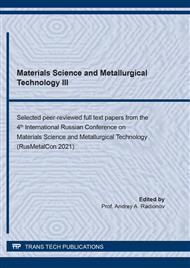[1]
ISO 14630-2017 Non-Active Surgical Implants. General Requirements.
Google Scholar
[2]
ISO 5832-2:1999 Implants for Surgery. Metallic Materials. Part 2. Unalloyed Titanium (IDT).
Google Scholar
[3]
ISO 5832-3: 1996 Implants for Surgery. Metallic Materials. Part 3. Wrought Titanium 6-Aluminium 4- Vanadium Alloy.
DOI: 10.3403/00977375
Google Scholar
[4]
ISO 5832-1:2007 Implants for Surgery. Metallic Materials. Part 1: Wrought Stainless Steel.
Google Scholar
[5]
ISO 5832-4:1996 Implants for Surgery. Metallic Materials. Part 4: Cobalt-Chromium-Molybdenum Casting Alloy.
DOI: 10.3403/30287964u
Google Scholar
[6]
K.E. Makhkamov, D.U. Israyilov, J.M. Kuzibaev, Post-operative complications at spine stabilization by transpedicular fixing, Shoshilinch Tibbiyot Axborotnomasi. 2 (2015) 15-18.
Google Scholar
[7]
J.M. Hicks, A. Singla, F.H. Shen, V. Arlet, Complications of pedicle screw fixation in scoliosis surgery, A Systematic Review, Spine. 35(11) (2010) 465-470.
DOI: 10.1097/brs.0b013e3181d1021a
Google Scholar
[8]
K.A. Berdyugin, A.K. Chertkov, D.I. Stadler et al., Mistakes and complications of transpedicular fixation of spine, Scientific Reviews. 4 (2012) 425-431.
Google Scholar
[9]
K.A. Berdugin, About fractures of metallosteosintesis as reason of unsatisfactory outcomes of transpedicular fixation, Journal of Experimental and Clinical Surgery. 3(4) (2010) 392-397.
Google Scholar
[10]
M.K. Hsieh, M.Y. Liu, J.K. Chen, T.T. Tsai, P.L. Lai, C.C. Niu, et al., Biomechanical study of the fixation stability of broken pedicle screws and subsequent strategies, PLoS ONE. 14(6) (2019) e0219189.
DOI: 10.1371/journal.pone.0219189
Google Scholar
[11]
A.A. Vishnevsky, V.V. Kazbanov, M.S. Batalov, Prospects of using titanium implants with predetermined osteogenic properties, Hir. Pozvonoc. 13(1) (2016) 50-58.
DOI: 10.14531/ss2016.1.50-58
Google Scholar
[12]
A.P. Avcyn et al., Human Microelementosis, Medicina, Moscow, (1991).
Google Scholar
[13]
F.Z. Savransky et al., Comparative analysis of the quality of the innovative surface system hsttm implants from Humana Dental GbmH with surfaces from leading manufacturers according to the criteria of the international standard ISIS, Eurasian Union of Scientists (ESU), Medical Sciences. 1-4 (22) (2016) 99-104.
Google Scholar
[14]
V.V. Savich, D.I. Saroka, M.G. Kiselev, M.V. Makarenko, Surface modification of titanium implants and its effect on their physicochemical and biomechanical parameters in biological environments, Belarus. Navuka, (2012).
Google Scholar
[15]
A.G. Serebrennikova, E.P. Nikolaeva, A.V. Savilov et al., Research results of stress-strain state of cutting tool when aviation materials turning, IOP Conf. Series: Journal of Physics: Conf. Series. 944 (2018) 012104.
DOI: 10.1088/1742-6596/944/1/012104
Google Scholar
[16]
A.V. Savilov, A.S. Pyatykh, S.A. Timofeev, Analysis of advanced transpedicular screw machining technologies, Proceedings of Irkutsk State Technical University. 24(6) 2020 1190-1198.
DOI: 10.21285/1814-3520-2020-6-1190-1198
Google Scholar
[17]
A.V. Savilov, V.M. Svinin, S.A. Timofeev, Investigation of output parameters of titanium reverse turning, IOP Conf. Series: Journal of Physics: Conf. Series. 1015 (2018) 042055.
DOI: 10.1088/1742-6596/1015/4/042055
Google Scholar
[18]
M. Bulbule, N. Hosamani, S.R. Chandramouli, Automated production of medical screws using titanium bar on indigenous sliding headstock automat, Advances in Forming, Machining and Automation, Proceedings of AIMTDR, Springer, Singapore, 2018, pp.709-722.
DOI: 10.1007/978-981-32-9417-2_60
Google Scholar
[19]
A.V. Savilov, A.S. Pyatykh, S.A. Timofeev, Optimization of machining processes based on modal and dynamometric analysis, Science and Technology in Industry. 1-2 (2013) 42-46.
Google Scholar
[20]
S.A. Timofeev, A.V. Savilov, A.S. Pyatykh, Studies on the effect of cutter wear on cutting dynamics when turning, Materials Today: Proceedings. 38(1112) (2021) 1367-1370.
DOI: 10.1016/j.matpr.2020.08.105
Google Scholar
[21]
A. Nikolaev, A. Savilov, Effects of tooling unbalance on surface roughness in end milling, Journal of Physics: Conference Series. 1791 (2021) 012019.
DOI: 10.1088/1742-6596/1791/1/012019
Google Scholar
[22]
A.V. Savilov, A.S. Pyatykh, S.A. Timofeev, The modern methods of optimization the high productive milling, Izv. SSC RAS. 15 (2013) 476-479.
Google Scholar
[23]
GOST 9.301-86 Unified System of Corrosion and Ageing Protection. Metal and Non-Metal Inorganic Coatings. General Requirements.
Google Scholar
[24]
I.V. Rodionov, Creation of biocompatible coatings on medical titanium implants by anodizing in sulfuric acid electrolytes, Perspektivnyye Materialy. 6 (2008) 45-54.
Google Scholar
[25]
GOST 9450-76 Measurements Microhardness by Diamond Instruments Indentation.
Google Scholar


